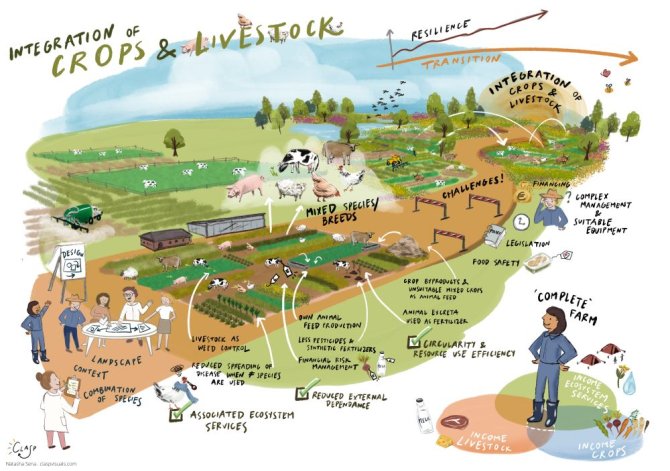Intercropping is considered to be a biodiversity-positive alternative to monocultures, but comes with several challenges. Some of these challenges can potentially be overcome through the inclusion of livestock in intercropping production systems.
For example, livestock can be fed with mixed crops and their byproducts, until the processing of intercropped products has been further developed. In return, the manure produced by the animals can be used to fertilise the soil. However, while the combination has its advantages, farming crops and livestock together requires substantial investments by the farmer.
"Diversification of farming systems is seen as a potential means to achieve agricultural transition towards more sustainable and biodiversity-positive food systems," says Gerbrich Bonekamp, researcher at Animal Breeding and Genomics (ABG). "Intercropping - the growing of multiple crops on the same field at the same time - is considered to be a possible alternative to large monocultures to reduce fertilizer and pesticide use while supporting biodiversity, but this comes with several challenges. Some of these challenges of intercropping can potentially be overcome through the inclusion of livestock in these production systems."
Researching crop-livestock systems
Together with several colleagues - dr. Malou van der Sluis (ABG), dr. Dirk van Apeldoorn of the Farming Systems Ecology group (FSE), dr. Raimon Ripoll Bosch of Animal Production Systems group (APS), and ir. Sipke Joost Hiemstra of the Centre for Genetic Resources, the Netherlands (CGN) - Gerbrich investigated the interactions between crop and livestock species, for further development and implementation of biodiversity-positive food systems.
The researchers focused on 1) the potential of crop-livestock combinations in intercropping systems, 2) the relevance of particular crop combinations in intercropping within crop-livestock systems, and 3) relevant criteria for the use of genetic resources in integrated crop-livestock farming systems. To this end, they used a literature review, farmer interviews, and a focus group discussion in which they worked together with a visual designer to develop an infographic on crop-livestock integration.

Infographic: Natasha Sena, Clasp Visuals
Potential benefits and current barriers
"We found that many of the potential benefits of crop-livestock integration hold true for intercropping-livestock integration as well," says researcher Malou van der Sluis. "For example, a potential benefit is that crop byproducts can be used as animal feed, and crops and trees can provide a source of shade and shelter for the animals. Moreover, livestock can contribute to weed management and pest control, and grazing by livestock can have a positive effect on soil health. And, last but not least, compared to crop- or animal-only systems, integrated crop-livestock systems have a higher biodiversity. This is both due to the direct integration of additional species in an integrated system, and the attraction of more species, for example through the addition of pastures on crop farms that may attract bees and other insects."
Although the report clearly shows that crop-livestock integration can contribute to improved biological resilience, improved economic resilience (and reduced external
dependence), and circularity and resource efficiency, there are also factors
that limit the implementation of crop-livestock systems. "The complexity of
integration can limit the adoption of integrated crop-livestock systems, as the
sector is currently mainly focused on single-crop or -livestock production,"
says Malou. "In addition, our interviews with farmers revealed that the
conversion to a crop-livestock system requires substantial financial
investments, and banks aren't always eager to provide loans for non-conventional
production plans. This makes it challenging to implement crop-livestock
integration in practice."






